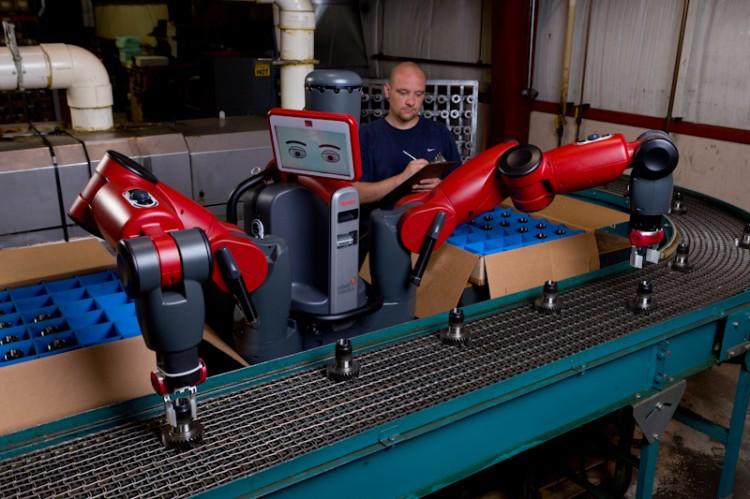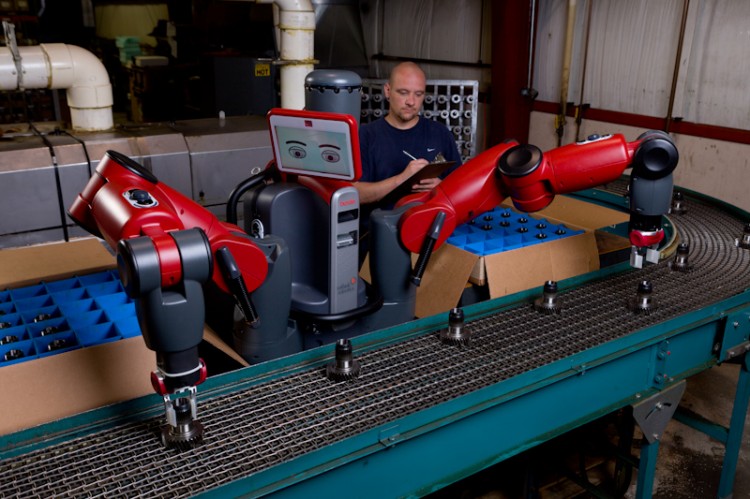Baxter could revolutionize the way American companies operate as they shift production back to the United States using the humanoid robot to save on costs. Rethink Robotics unveiled its flagship product to the public Sept. 18.
“Roboticists have been successful in designing robots capable of super-human speed and precision. What’s proven more difficult is inventing robots that can act as we do—in other words, that are able to inherently understand and adapt to their environments,” said company founder Rodney Brooks, an artificial intelligence legend and robotics pioneer having spent much of his life teaching at MIT. Rethink was founded in 2008 with the purpose of designing a robot like Baxter and carries a few other products. It is currently owned by venture capital firms and Brooks.
He further notes that providing a flexible and inexpensive solution—the robot costs only $22,000—Rethink specifically hopes to contribute to a revival in American manufacturing. “We believed that if we could cross that chasm with the manufacturing environment specifically in mind, we could offer new hope to the millions of American manufacturers who are looking for innovative ways to compete in our global economy.”
Baxter Solves Problem of Safety, Adaptability, and Programming
Baxter, which is exclusively produced in the United States and will first ship in October, aims to solve some of the long-standing issues with automation. The most important one is safety, as most industrial robots on assembly lines operate far away from humans or need to be caged to prevent injury. Rethink’s robot, which has a screen as a head and big flexible arms, is also equipped with Sonar sensors and software that help it detect human activity. In addition, it is programmed to stop its relatively gentle movements as soon as it detects resistance. A promotional video shows the robot standing on a fixed platform and the company has not commented on whether it can also walk.
“The class of products that can work side by side with people without any protection, those would be important developments. They could take robots from a factory environment … where people would have to be kept away, into more areas … some outside of factories,” says Jeff Burnstein, president of the Robotic Industries Association, an organization that provides education and information for companies interested in automating workflows.
Another big advantage is the ease of use. Normally, industrial robots need technical personnel to be programmed to perform a limited amount of tasks in an effort that involves special software and more often than not can take up to a full day. Baxter, which can be employed in less than an hour after being delivered, can be trained by any type of personnel by merely showing it how to perform a wide range of tasks, such as material handling, line loading, light assembly, or packing products.
In practice this would mean that the employee would move Baxter’s arms to perform the desired process and chose one of several preprogrammed options by way of twisting a few dials. The robot can also adapt to changes in the environment, for example if it drops an object, it knows to get another before trying to finish the task, unlike other robots, which have been seen picking air for a whole day, if no human supervises them.
“[This class of robots] doesn’t need a whole lot of programming. … That’s important. There are a number of companies that either don’t have the in-house expertise or they don’t want to pay for outside assistance,” said Burnstein in an Epoch Times interview.
“Because of its versatility and the short amount of time it takes to retrain, Baxter can be easily moved by production personnel to different and varying tasks over the course of a day, week, and month,” says the company’s press release. Most of the claims that the company makes in the press release can be tracked in a promotional video and also have been tried in practice when Baxter was on loan at Vanguard Plastics, a small manufacturer based in Connecticut, writes Will Knight of technologyreview.com.
Jeff Burnstein cautions, however, that the ultimate success will be determined after the product is rolled out. “Until these products are out in big numbers you don’t know if they are safe or not.”
New Automation Style Could Revolutionize Manufacturing
If Baxter or similar robots can be rolled out on a large scale, it could mean big things for American manufacturing. Given the fact that robots like Baxter are inexpensive, flexible, and do not need much maintenance in terms of programming, they can be used in companies of all sizes that face tough options in competing with low-wage countries. AFL-CIO, the umbrella federation for 56 U.S. unions cites Bureau of Labor Statistics data saying that 5.5 million jobs were lost in the process of offshoring.
“[This development] will either save or create new jobs,” believes Burnstein. “We would hope that companies that would have otherwise either closed down because they can’t compete or sent manufacturing jobs overseas will decide to automate in order to keep jobs in the United States.”
Bob Baugh, executive director of the AFL-CIO industrial union council, representing the manufacturing unions within the umbrella organization agrees: “If you are more productive this way, you can share the benefits. … [The] productivity is shared with the workforce and the community and the country in a sense that people earn better wages and income. [They] are compensated for these productivity gains that come with the interface with human interaction with technology to produce goods.”
The idea is as follows: A humanoid robot would boost human labor productivity in such a way that it would reduce costs and boost output without reducing employment here. Increased output at lower costs would mean more capital accumulated and wages paid in the United States, leading to greater economic prosperity, even outside manufacturing.
A simple example would see an American company closing its factory in China, because it is upset with intellectual property theft and corrupt business practices as well as rising wages over there. It would then reopen production in the United States, hiring workers and supplementing them with flexible automation solutions. Jobs and output are created in the United States, leading to more jobs and output created in the United States.
Jeff Burnstein sees numerous reasons why reshoring makes sense: “When you build domestically you are closer to your customers, you don’t have to deal with political instability … the fear of your IP being stolen. There are a lot of reasons if all things are equal why you would want to build domestically. … Automation and robotics in particular is allowing companies to do that, we are seeing signs of that.”
According to Bob Baugh, automation is also seen as a positive by the unions, as long as some standards are met: “Workers [need to be] compensated well and have a good work environment where they do these things and that they have the skills to operate the technology and equipment.”
These new developments in automation seem to be a win-win situation that might even lead to American companies becoming export leaders again one day in the not too distant future.
The Epoch Times publishes in 35 countries and in 19 languages. Subscribe to our e-newsletter.







